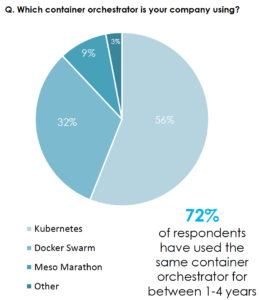Survey: Kubernetes Deployments Can Be Hard to Navigate

via Shutterstock
A vendor survey of early Kubernetes adopters embracing cloud-native applications finds that high-maintenance microservices and API sprawl have created a new set of security and networking issues for some users. The result is that few of the surveyed respondents are running most of their enterprise applications on the popular container orchestrator.
The report, released this week by distributed cloud services vendor Volterra Inc., found that 56% of its respondents are using the Kubernetes container orchestration platform in some capacity. However, only 10 percent of those early adopters are running a majority of their business apps on the platform. Santa Clara, Calif.-based Volterra commissioned its cloud-native apps study in October. The online study, which was conducted by Propeller Insights, gathered responses from more than 300 U.S.-based IT managers and corporate executives. Eighty-three percent of the respondents work at mid-sized companies with 500 to 5,000 employees, while 17% work at large enterprises with more than 5,000 employees. Some 89% of the respondents work in DevOps, infrastructure and operations or as part of an application team, according to the survey.
While 86 percent of those polled said they are using cloud-native applications running on multiple clouds, the most popular workload was corporate databases (92 percent) followed by data warehousing and analytics (84 percent). Machine learning and AI deployments ranked third at 75 percent.
The survey found that security and connectivity challenges are preventing some organizations from using microservices for more of their business apps, with 57% of respondents saying that less than 10% of all their business apps are based on microservices architecture. Eighty-eight percent of the respondents reported that less than 25% of business apps are using microsoervices architectures.
Public cloud vendors, including Kubernetes developer Google Cloud, have sought to plug security gaps through greater use of hardware-based encryption to create “confidential Kubernetes nodes.” As a result of those and other security efforts, Kubernetes remains the most popular container orchestration platform for cloud-native applications.
Another issue is the growing number of APIs associated with cloud- native applications. “Cloud-native apps rely heavily on a microservices architecture and use far more APIs than traditional monolithic apps, including deeply embedded and hidden APIs,” said Mark Weiner, Volterra’s chief marketing officer.
“This increase in microservices and APIs makes modern apps far more complex to secure and connect,” Weiner added. “As a result, organizations are really struggling to get the agility and scalability they expected from their cloud-native environment and investment.”
Asked what challenges they face in deploying, linking and securing Kubernetes deployments, more than three-quarters of respondents cited both maintaining security across clusters and “meeting required agility or timelines for activating clusters.”
Others cited operational complexities associated with Kubernetes as their largest time sink.
Some survey respondents reported that they didn't have Kubernetes security concerns. For one respondent, the multi-cloud approach is seen as one way of securing networks that support Kubernetes deployments. “Each (cloud) provider offers a different service and, in this way, they complement each other, forming a secure network,” the respondent said.
Another respondent had similar feedback. “I really do not think that we face any types of challenges with securing the Kubernetes environment other than maybe it taking a little more time to complete the process,” they said.
Related
George Leopold has written about science and technology for more than 30 years, focusing on electronics and aerospace technology. He previously served as executive editor of Electronic Engineering Times. Leopold is the author of "Calculated Risk: The Supersonic Life and Times of Gus Grissom" (Purdue University Press, 2016).











